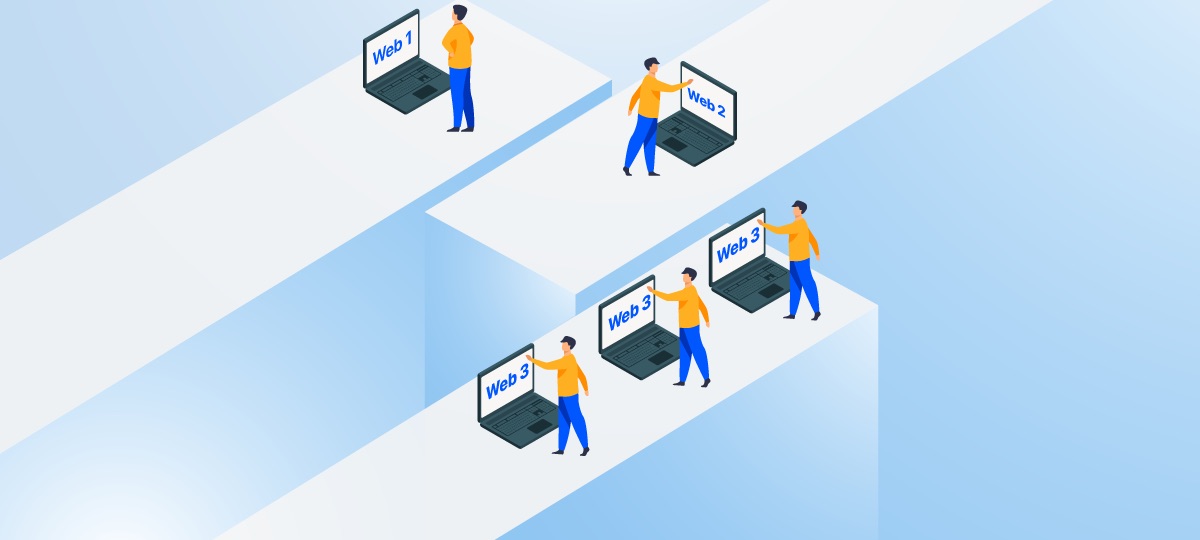
Web1, Web2 and Web3 – A Quick and Dirty Comparison
Let’s start with an understatement: the internet rocks. It keeps the world connected, the economy flowing, industries running, the ones you love close and the ones you don’t, blocked. Everyone is happy.
What most people don’t see or, more typically, don’t care enough to see, is that behind the curtain of utility, there is a central authority that puppeteers your world wide web experience.
A thick layer of data control lies heavily on top of your bandwidth. The sites you visit, the items you search for or (especially) the ads you click – all recorded for the sake of personalizing your experience.
What we just described is the internet we currently use, also known as Web2. For most of us, staying comfy in the bubble of our own interests at the cost of a little privacy isn’t so bad. For others, it’s a problem. Web3 was designed initially to solve that problem. As the concept evolves, developers are realizing more functionality that a decentralized internet can offer.
This article will discuss the similarities and differences between Web1, Web2 and Web3 and how they will impact the way we process information in the future.
Web1 and Web2
Web1 was the internet at its most primitive stage. In this era, websites were read-only informational pages. There were no options to comment or suggest. You could send emails but only texts and not photos or upload any images. Some use the term Content Delivery Network (CDN) to describe Web1 because all it did was showcase raw data.
Early Internet-based business, including classic brands like Google and Yahoo, had all emerged from Web1.
Web2 is the internet we know now, an evolution from the static pages. User interaction is the main focus at this stage. This marked the rise of social media, blogs, and online gaming.
During the early days of Web2, instant messaging, or IM, was a big deal. Those who grew up in the 90’s will remember Yahoo Messenger and the little ding ding! sound whenever someone sent a ping.
Things eventually grew into file sharing and user-generated content. These include blogging, custom websites, podcasts, video streaming and webinars. We’re at a point where the internet is a consequential part of our life, as much as food and water.
One important aspect of Web2 is ownership versus access. You’re free to use almost any website on the internet, make an account and consume whatever content it provides. However, the account and everything else associated with it, including which you may have paid for, doesn’t belong to you.
When you use an online app, or a game, regardless if you may have purchased a license to use it, it’s not yours. You’re only paying to access it. Everything still belongs to the company behind it.
In the grand scheme of things, no one really owns anything on the internet, except maybe the ISPs themselves. Even the companies who made all the games and apps needed to pay for their own access. Though it rarely ever happens, if a provider decided to withdraw access, it may do so on a whim.
Web3
You can roughly call Web3 the decentralized internet. It functions similarly to a blockchain, which is why some people use them interchangeably.
As opposed to Web2 where there’s a central server controlling user activities, everyone is a server on Web3. Each individual network on Web3 is responsible for maintaining it and other attendant services.
Users have full ownership and control over their data on Web3. It’s also easier to transfer digital assets and cryptocurrency on the decentralized web. When you use an app on Web3 (which are also known as Dapps), you can help build and maintain it or even purchase partial ownership of it.
The biggest compromise for all this is speed. Things are processed at a fraction of the speed of Web2. Blockchains, such as Bitcoin and Ethereum, all share the same struggle in throughput rates.
The heightened privacy also comes with a lack of control. Web3 claims to stand free of censorship, which means there’s no barrier against hateful content, cyberbullying, cyber crimes and all the other things your Web2 ISP used to keep away from you.
Closing Words – Can Web3 Become the Norm?
It is simply too early to tell, but one thing for sure is that Web2 will remain the predominant internet for a long time.
As of now, Web3 is too difficult and expensive to use for an average person, on top of the flaws mentioned above.
One thing it does well is bring like-minded, tech savvy people together. Developers can easily collaborate on Dapps and maintain a blockchain. NFT enthusiasts also make good use of the ease of transfer and smart contracts. Unfortunately, that also isolates them from the rest of the regular web users.
For Web3 to work, it needs to become easy to manage and include users of all levels. At its current stage, that seems like a long term goal.
